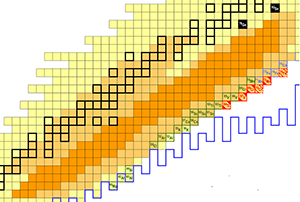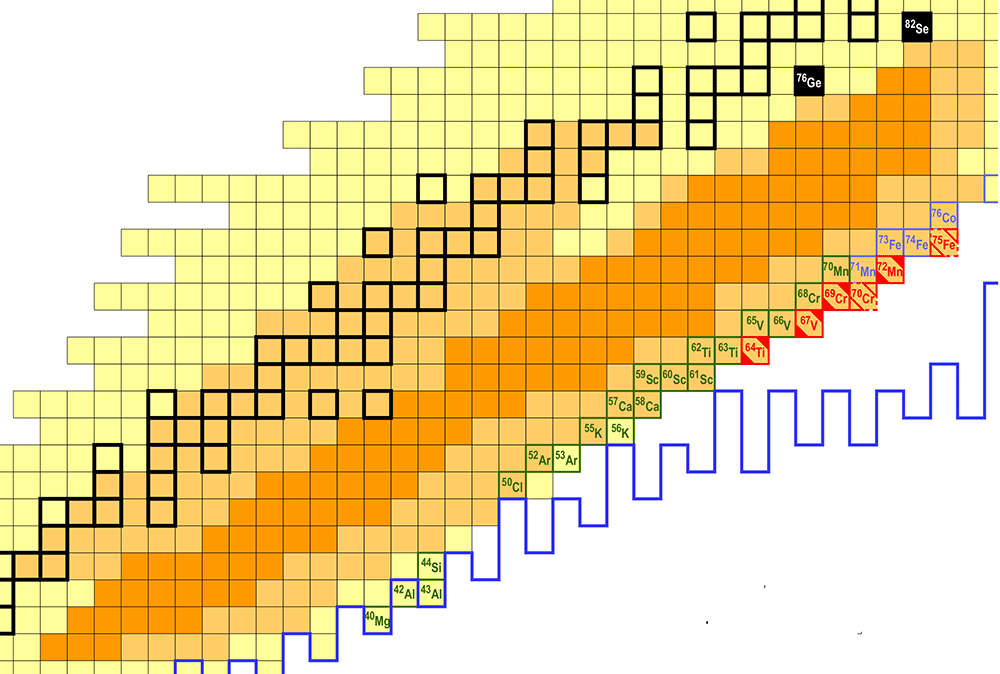Pushing Back the Frontier of Stability
Ask what holds protons and neutrons together in the nucleus and the answer is straightforward: It’s the strong force between quarks. Ask instead how many protons and neutrons a nucleus can contain before it falls apart and the answer isn’t nearly so concise. The reason is that the nucleus is a many-bodied object, and the interactions between protons and neutrons are complex. Models of these interactions have been successful at predicting the mass and structure of stable nuclei, but they must be modified to describe the neutron- and proton-rich isotopes that approach the edge of stability. The ability to model neutron-rich nuclei is of particular interest because they play a key role in the stellar nuclear reactions that form all heavy elements and the formation and structure of neutron stars.
The best way to make and study the most neutron-rich nuclei is at advanced accelerators around the world. In Physical Review C, Oleg Tarasov at the National Superconducting Cyclotron Laboratory (NSCL) at Michigan State University, East Lansing, and colleagues report an analysis of neutron-rich isotopes of the elements sodium through germanium, including four isotopes that have been observed for the first time [1]. The scientists produced the isotopes (Fig. 1) by fragmenting an energetic beam of selenium- ( ) nuclei on targets made of different types of metals and carefully measured the production rates of each one. They show that the measured rates fit well to simulations based on a particular theoretical model—one that takes into account tensor and three-body interactions between nuclei and may explain the properties of lighter neutron-rich isotopes. Although this model has been tested in other experiments, the new measurements provide an important independent check in heavier and more neutron-rich isotopes.
Of the stable or long-lived elements in the universe, each has (on average) about three stable or long-lived isotopes. There are few proton-rich nuclei because of the strong electromagnetic repulsion between particles with the same charge, but there can be a relatively large number of neutron-rich isotopes for a given element. The heaviest neutron-rich isotope of each element delineates the “neutron-drip line.” The weakly bound neutrons in isotopes near the drip line interact in complex ways, in some cases forming “skins” or “halos” at the periphery of the strongly bound core of protons and neutrons. These exotic isotopes are short-lived and their properties are determined by nuclear interactions that aren’t prevalent in more stable nuclei. All together, nuclear scientists have created or observed nearly isotopes [2]. However, the unexplored nuclear landscape is vast: Nuclear theory predicts (with about uncertainty) the existence of roughly isotopes [3].
The identification of new neutron-rich isotopes is occurring faster than ever before. These discoveries are occurring primarily at the most recently constructed or upgraded heavy-ion accelerators, including at GSI in Germany, RIKEN in Japan, GANIL in France, and the NSCL. At these facilities, experimentalists analyze isotopes created from either the in-flight fission of uranium beams or the fragmentation of uranium or other elements. In 2010, researchers at RIKEN discovered new isotopes in the – range [4]; GSI followed with a similarly impressive report of new isotopes in the – range in 2012 [5].
Compared to these numbers, the NSCL discovery of only four new isotopes—one for each of the elements titanium, vanadium, chromium, and manganese—may seem small. But NSCL’s achievement is in how sensitively they are able to measure the isotope production rates. The probability of producing a given isotope (say, in a fragmentation process) depends on its “cross section,” which is the effective area, measured in units of barns, of the target nucleus for the creation of that isotope ( barn = ). Isotopes with small cross sections are very hard to make, requiring either long beam times or extremely intense beams. Whereas the RIKEN and GSI experiments were sensitive to isotopes with cross sections as low as barns, the experiment is able to observe new isotopes with cross sections less than barns. Tarasov et al. showed, for example, that nuclei of must pass through the target to create a single nucleus.
Identifying a new isotope for the first time is not usually a significant event in its own right. Instead, the exciting physics comes from measuring the isotope’s properties, such as its mass, lifetime, and the energies of its low-lying states. Such measurements require the production of more than just the two or three nuclei needed to establish the existence of a new isotope. But the accelerators and measurement techniques that enabled the observation of these new isotopes has also allowed researchers to perform more detailed studies of less exotic, more abundant nuclei.
In particular, nuclear physicists are using these tools to figure out how to adapt a fundamental model in nuclear physics, called the shell model, to describe neutron-rich isotopes. The shell model predicts that there are certain “magic numbers” of protons and neutrons that give rise to highly stable nuclei. These numbers are associated with the filling of neutron and proton energy levels (or shells) similar to the closure of electron orbitals in inert atoms. But the situation in neutron-rich nuclei has proven to be more complicated. The magic numbers that apply to stable nuclei can change as neutrons are added. Such “islands of inversion” have been discovered in relatively light neutron-rich nuclei in the region between and [6]. Theoretical work is now focused on understanding the components of the nuclear force that give rise to these surprising properties [7,8]. Terms in the nuclear force, such as tensor and three-nucleon interactions, are believed to play an important role. Such terms can explain, for example, the surprising discovery that is the heaviest radioactive isotope of oxygen.
In Tarasov et al.’s experiment, in fact, the first hints of physics have come from noticing anomalies in the systematics of the cross sections of the discrete isotopes. The yields of these isotopes plotted against simulations of their masses show a preference for models that account for the tensor and three-nucleon forces.
The results of the present experiment have important implications for nuclear physics, in both the near term and in years to come. Already, follow-up experiments at the NSCL are using the beam in combination with a new gamma-ray detector array, called GRETINA [9]. In these experiments, the focus is on studying more abundant fragments, rather than the most exotic ones. Tarasov et al.’s data also bode well for planned experiments at the Facility for Rare Isotope Beams (FRIB), presently under construction at Michigan State University [10]. Based on the cross sections predicted by the experiment [1], FRIB should be able to produce the exotic isotope at the rate of per day. This dramatic breakthrough in production rate for such very exotic isotopes will enable rapid advancement in our understanding of nuclear matter and related astrophysical phenomena.
References
- O. B. Tarasov et al., “Production Cross Sections from Se Fragmentation as Indications of Shell Effects in Neutron-Rich Isotopes Close to the Drip-Line,” Phys. Rev. C 87, 054612 (2013)
- M. Thoennessen, ”The Discovery of the Nuclides,” Nucl. Phys. News 22, No. 3 , 19 (2012); Discovery of Nuclides Project, http://www.nscl.msu.edu/~thoennes/isotopes/
- J. Erler, N. Birge, M. Kortelainen, W. Nazarewicz, E. Olsen, A. M. Perhac, and M. Stoitsov, “The Limits of the Nuclear Landscape,” Nature 486, 509 (2012)
- T. Ohnishi et al., “Identification of 45 New Neutron-Rich Isotopes Produced by In-Flight Fission of a 238U Beam at 345 MeV/nucleon,” J. Phys. Soc. Jpn. 79, 073201 (2010)
- J. Kurcewicza et al., “Discovery and Cross-Section Measurement of Neutron-Rich Isotopes in the Element Range from Neodymium to Platinum with the FRS,” Phys. Lett. B 717, 371 (2012)
- S. Takeuchi et al., “Well Developed Deformation in Si,” Phys. Rev. Lett. 109, 182501 (2012)
- G. Hagen et al., ”Evolution of Shell Structure in Neutron-Rich Calcium Isotopes,” Phys. Rev. Lett. 109, 032502 (2012)
- O. Sorlin and M-G Porquet, “Evolution of the N=28 Shell Closure: A Test Bench for Nuclear Forces,” Phys. Scr. T152, 014003 (2013)
- H. Crawford, “Abstract C3.00003: First Results from GRETINA at the S800 Spectrometer,” Bull. Am. Phys. Soc. 58, 4 (2013); http://meetings.aps.org/link/BAPS.2013.APR.C3.3
- J. Wei; et al., The FRIB Project – Accelerator Challenges and Progress, Proceedings of HIAT 2012, Chicago, IL USA, June 18-21, 2012; http://www.phy.anl.gov/hiat12/Proceedings/index.htm





